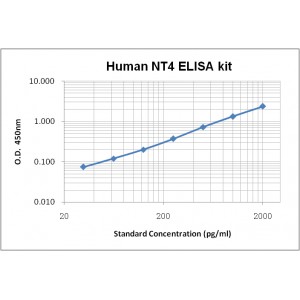More info
Assay Range | 31.2-2,000 pg/mL |
Sensitivity | 10.0 pg/mL |
Specificity | No cross-reaction with other related substances detected |
Size | 96T |
Storage | Store at 2 - 8ºC. Keep reconstituted standard and detection Ab at -20 ºC |
Assay Principle | Sandwich ELISA |
Sample Volume | 100 µL final volume, dilution factor varies on samples |
Detection Method | Chromogenic |
Kit Components
1. Recombinant Human NT-4 standard: 2 vials
2. One 96-well plate coated with Human NT-4 Ab
3. Sample diluent buffer: 12 mL - 1
4. Detection antibody: 130 µL, dilution 1:100
5. Streptavidin-HRP: 130 µL, dilution 1:100
6. Antibody diluent buffer: 12 mL x1
7. Streptavidin-HRP diluent buffer: 12 mL x1
8. TMB developing agent: 10 mL x1
9. Stop solution: 10 mL x1
10. Washing solution (20x): 25 mL x1
Background
Neurotrophin4 (NT-4), also known as NT-5 or neutrophic factor 4, is a member of the NGF family in which at least four proteins including NGF, BDNF, NT3, and NT-4/NT-5 have been identified. All of these proteins have six conserved cysteine residues that are required for the formation of three disulfide bonds and all share approximately 55% amino acid (aa) sequence identity. The human NT-4 is synthesized as a 210 aa precursor composed of a 24 aa signal sequence, a 56 aa propeptide, and a 130 aa mature protein. Mature human NT-4 shares 48- 52% aa sequence identity with human NGF, BDNF, and NT-3. It shares 91% and 95% aa sequence identity with mouse and rat NT-4, respectively. Expression of NT-4 has been detected in prostate, thymus, placenta, and skeletal muscle during embryonic development and adulthood.
NT4 binds and activates the receptor tyrosine kinase TrkB to initiate a series of cellular processes in target cells. NT-4 plays a key role in the development and survival of target neurons in peripheral and central nervous systems. It also promotes the proliferation of keratinocytes and accelerates hair follicle regression during the follicular cycle. It is reported that NT-4 is secreted by activated T cells and granulocytes at sites of inflammation to assist tissue regeneration.


